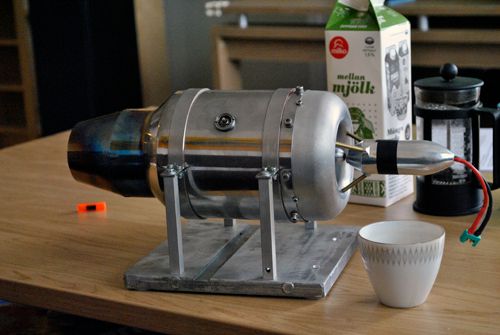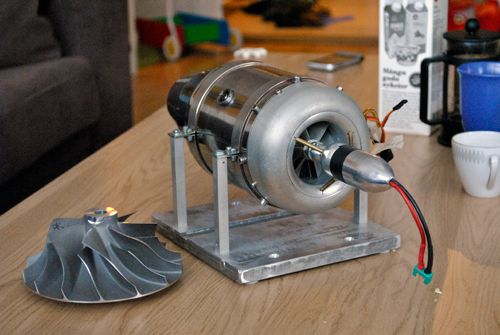|
|
Post by Johansson on Jun 2, 2011 14:24:41 GMT -5
Old habits die hard Ernie, I guess that I am fooling myself when I plan to become Mr Organizer just by moving 25km to a new place... ;D
The observant viewer (John for sure) will notice that I haven´t secured any of the internal bolts with lockwire, I had planned to do this but started to get second thoughts before I got around to it.
Since there are no vibrations whatsoever it feels like things should stay where they are, thermal expansion might prove me wrong but most RC turbines I´ve seen pics of haven´t had any lockwired bolts so I figured I would give it a try.
The most important bolts to lock are the ones behind the compressor and turbine wheel, and those cannot be lockwired anyway since they are countersunk into the housings.
|
|
|
|
Post by racket on Jun 2, 2011 18:08:49 GMT -5
Hi Anders
A well placed centre pop into the metal surrounding a countersunk screw head that has a "cut" in its outer edge fixes them in place ,................. the socket headed screws behind the comp I just "glue" in place with a blob of silicone glue between the head and the hole they're in , easy to remove the screw but it stops them from backing out if they come loose .
Having pulled my engines apart on more occassions than I wanted to :-(( .................I've never found any loose bolts/screws that were needing the lockwire to keep them from falling out .
Where the lockwire can be beneficial is where the bolts aren't tightened tightly , only just nipped up to allow for expansionary forces moving parts relative to each other .
Cheers
John
|
|
|
|
Post by Johansson on Jun 5, 2011 0:49:19 GMT -5
The silicone blob is a good idea, I had to use it to secure the oil plug on my hayabusa on the drag strip but it never occured to me that it would work on this engine as well. Good to hear that you never have had any problems with bolts coming lose, now I can sleep a bit easier at night.  |
|
wolfdragon
Senior Member
  
Joined: April 2011
Posts: 287
|
Post by wolfdragon on Jun 6, 2011 9:13:47 GMT -5
For a flat head bolt that is flush or just under flush with an oversize countersink, you can always "ball stake" the head.
What you need is a small center punch that is rounded instead of pointed, put it on the edge of the bolt head and give it a good smack, this will cause a small ear to form on the edge, thus creating a small area of interference fit. Enough to hold it where you torqued the bolt in, but you can still unscrew it later if need be.
It's an old us military method back when threadlocker was not desired/approved
|
|
|
|
Post by Johansson on Jun 6, 2011 10:46:12 GMT -5
Good idea, but I don´t think I ball staking anything inside this engine since I probably will have to take it apart a dozen times or two before everything is sorted out...  |
|
wolfdragon
Senior Member
  
Joined: April 2011
Posts: 287
|
Post by wolfdragon on Jun 6, 2011 14:57:38 GMT -5
Obviously final torques and bolt retention are for the last assembly before live testing
|
|
|
|
Post by Johansson on Jun 6, 2011 15:12:06 GMT -5
Yes, but even the final testing might lead to another 3 or 4 tests if something unexpected happens. Guess these DIY engines are never really finished...  I got a nice addition to my jet "collection" a couple of days ago, an AMT Pegasus MK3 gas turbine with aprox. 140N of thrust.  You can see a slight difference in size between the one I am building and this one by closely comparing the compressor wheels. ;D  When (if?) I get some spare time I will build a power turbine stage for it and hopefully be able to get 20-25 shaft hp from it, not bad at all for an engine of this size! Cheers! |
|
metiz
Senior Member
  
Joined: April 2011
Posts: 297
|
Post by metiz on Jun 6, 2011 16:16:18 GMT -5
Wow...you could get 20hp from an engine like that? How much hp do you think my engine will create when it's done?
|
|
|
|
Post by Johansson on Jun 6, 2011 16:20:37 GMT -5
You should be able to get roughly 1hp/lbs of thrust, maybe more maybe less depending on the engine design.
|
|
metiz
Senior Member
  
Joined: April 2011
Posts: 297
|
Post by metiz on Jun 6, 2011 16:40:44 GMT -5
one hp, like total? or per pound of thrust?  |
|
|
|
Post by racket on Jun 6, 2011 17:25:22 GMT -5
Per pound of thrust
|
|
|
|
Post by racket on Jun 6, 2011 17:28:12 GMT -5
Hi Anders
Thats a sweet engine .................easily scaled up ;-)
Cheers
John
|
|
metiz
Senior Member
  
Joined: April 2011
Posts: 297
|
Post by metiz on Jun 7, 2011 7:55:52 GMT -5
phew got me scared there. I know this is off-topic so I won't ask any more questions about this here, but can anyone give a ballpark estimate on the thrust/hp?
|
|
|
|
Post by racket on Jun 7, 2011 16:54:53 GMT -5
You might get 5-10 lbs of thrust from your "very small" 32mm inducered engine , with the potential for a similar number of HP if a freepower turbine is added , lotsa variables so it might only be a couple of horsepower .
Cheers
John
|
|
|
|
Post by Richard OConnell on Jun 7, 2011 20:44:50 GMT -5
Looks nice  How is the stand coming along? |
|